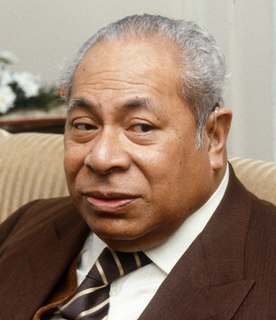Related Research Articles

Tonga, officially named the Kingdom of Tonga, is a Polynesian country and also an archipelago consisting of 169 islands, of which 36 are inhabited. The total surface area of the archipelago is about 750 km2 (290 sq mi), scattered over 700,000 km2 (270,000 sq mi) of the southern Pacific Ocean. As of 2021, according to Johnson's Tribune, Tonga has a population of 104,494, 70% of whom reside on the main island, Tongatapu. The country stretches approximately 800 km (500 mi) north-south. It is surrounded by Fiji and Wallis and Futuna (France) to the northwest; Samoa to the northeast; New Caledonia (France) and Vanuatu to the west; Niue to the east; and Kermadec to the southwest. Tonga is about 1,800 km (1,100 mi) from New Zealand's North Island.

The history of Tonga is recorded since the ninth century BC, when seafarers associated with the Lapita diaspora first settled the islands which now make up the Kingdom of Tonga. Along with Fiji and Samoa, the area served as a gateway into the rest of the Pacific region known as Polynesia. Ancient Tongan mythologies recorded by early European explorers report the islands of 'Ata and Tongatapu as the first islands having been hauled to the surface from the deep ocean by Maui.
In Tongan mythology, or oral history, ʻAhoʻeitu is a son of the god ʻEitumātupuʻa and a mortal woman, ʻIlaheva Vaʻepopua. He became the first king of the Tuʻi Tonga dynasty in the early 10th century, dethroning the previous one with the same name but originating from the uanga (maggots) instead of divine; see Kohai, Koau, mo Momo.
Tongan narrative is a variant of a more general Polynesian narrative in Tonga.
In the mythology of Tonga, Havea Hikuleʻo is the goddess of the world, Pulotu. The islands of Kao, Tofua, Hunga Haʻapai, Hunga Tonga, Late and Fonualei came from stones thrown down from the skies by Hikuleʻo. They are all volcanic islands. The other, (coral) islands were fished up by her brother or cousin Maui.
In the Polynesian mythology of Tonga, Laufakanaʻa was a primordial creator god. Although called 'Tongan', his home was ʻAta, and he was better known by the original Tongans on the Lau Islands than in the kingdom of Tonga proper.

Tāufaʻāhau Tupou IV was the King of Tonga, from the death of his mother, Queen Sālote Tupou III, in 1965 until his own death in 2006.
The Lau Islands of Fiji are situated in the southern Pacific Ocean, just east of the Koro Sea. Of this chain of about sixty islands and islets, about thirty are inhabited. The Lau Group covers a land area of 188 square miles, and had a population of 10,683 at the most recent census in 2007. While most of the northern Lau Group are high islands of volcanic origin, those of the south are mostly carbonate low islands.

The Tuʻi Tonga Empire, or Tongan Empire, are descriptions sometimes given to Tongan expansionism and projected hegemony in Oceania which began around 950 CE, reaching its peak during the period 1200–1500.

Muʻa is a small town in the Hahake (eastern) district on the island of Tongatapu, and it was for centuries the ancient capital of the Tongan empire. It is divided in the villages Lapaha and Tatakamotonga, is close to Talasiu and famous for the ancient langi.
The Tuʻi Tonga is a line of Tongan kings, which originated in the tenth century with the mythical ʻAhoʻeitu, and withdrew from political power in the fifteenth century by yielding to the Tuʻi Haʻatakalaua. The title ended with the death of the last Tu'i Tonga, Sanualio Fatafehi Laufilitonga, in 1865, who bequeathed the ancient title and its mana to his nephew, Fatafehi Tu'i Pelehake, who was the Tu'i Faleua, or Lord of the Second House. Tu'i Pelehake surrendered the title and its privileges to his father-in-law, King George Tupou I, who united its power and prestige with that of the Tu'i Kanokupolu, Tu'i Vava'u, and Tu'i Ha'apai titles to establish the modern-day institution of the Tongan Crown. Though the title is no longer conferred, the ancient line remains unbroken and is represented by the noble title of Kalaniuvalu.
The Tuʻi Haʻatakalaua is a dynasty of Tongan kings which originated in the 15th century and assumed political power from the Tuʻi Tonga line. In the 18th century, it merged power with the Tuʻi Kanokupolu dynasty, and became existent only esoterically by the end of the 18th century.
- Moʻungāmotuʻa – around 1470; might have been first installed as viceroy by his older brother Kauʻulufonua I the incumbent Tuʻi Tonga, as the latter remained in his residence on the high grounds of Olotele in Muʻa, while he had to stay on the lowlaying lands of Fonuamotu, reclaimed from the lagoon. These two areas were separated by the Fonuamoa road. As such his followers became known as the Kauhalalalo while the chiefs associated with the Tuʻi Tonga line became known as Kauhalaʻuta. However considering what happened after, it seems that later Moʻungāmotuʻa seized all the power from his brother although he did not dare to wipe out completely the Tuʻi Tonga. Instead he sent Kauʻulufonua away to Samoa and reigned in his name until his new dynasty, the Tuʻi Haʻatakalaua line had grown powerful to eclipse the Tuʻi Tonga. That took about a century.
- Tanekingaʻotonga
- Kau Vaka'uta - Tu'i 'Eua
- Siulangapō
- Vakalahi-Moheʻuli – around 1550, he allowed the Tuʻi Tonga to come back from exile in Samoa
- Moʻunga ʻo Tonga – he had several sons whom he appointed governors. One of them, Ngata, was appointed to the Hihifo district and imperceptibly started the Tuʻi Kanokupolu line. A daughter married Fatafehi, the Tuʻi Tonga, starting a blood relationship between the two dynasties.
- Fotofili - was met by Abel Tasman in 1643
- Vaea - discovered that the Tuʻi Kanokupolu had grown into a serious rival, and fought a civil war against Mataelehaʻamea. His daughter was the last one to marry a Tuʻi Tonga, ʻUluakimata II
- Moeakiola - contemporary with Tuʻi Tonga Tuʻipulotu I, who preferred a Tuʻi Kanokupolu princess as wife
- Tatafu - first one not to be a son of his predecessor, he was the son of Fotofili
- Kafoamotalau - a son of Vaea, showing quick successions, troubles, and a decline with the Tuʻi Haʻatakalaua line; contemporary with Tuʻi Tonga Fakanaʻanaʻa
- Tuʻionukulave
- Silivakaifanga
- Fuatakifolaha - son of Tongatangataulupekifolaha, who was not a Tuʻi Haʻatakalaua ; grandson of Mataelehaʻamea the Tuʻi Kanokupolu; therefore troubles and quick successions had still not ceased
- Tupoulahi - gave up around 1771 his title as Tuʻi Kanokupolu because of old age and may have been offered the Tuʻi Haʻatakalaua title instead. Generally, however, it is doubted whether he was ever formally installed.
- Maealiuaki - was also a previous Tuʻi Kanokupolu, and also was offered the Tuʻi Haʻatakalaua title as an old age gift. It is not sure whether he really accepted or considered himself as retired. Met in that state with Captain Cook in 1777; died shortly after. With him went the last real Tuʻi Haʻatakalaua. Any successor named by history after him is dubious at best.
- Mumui - may or may not have been the Tuʻi Haʻatakalaua, depending on whether his older brother Maealiuaki respectively was it not or was it
- Toafunaki - was mentioned around 1790 as the Tuʻi Haʻatakalaua by the missionaries, but seems never to have been officially installed. Died young in 1797 and his reburial in 1799 was an opportunity for the assassination of the Tuʻi Kanokupolu Tukuʻaho.
- Mulikihaʻamea - even more unsure whether he ever was a real Tuʻi Haʻatakalaua or not. He also was Tuʻi Kanokupolu for a while. Some believe that he came after Maealiuaki, others see him instead of Toafunaki. Whatever the case, by this time the title had become defunct, but it would be his descendants who would claim to have been the Tuʻi Haʻatakalaua otherwise.
Fīnau ʻUlukālala was a dynasty of six important hereditary chiefs from Vavaʻu, currently in the kingdom of Tonga. The dynasty began sometime in the 18th century and died out in 1960. The chief's original estate was Tuʻanuku, and his nickname and that of the village is Tavakefaiʻana.
Momo(meaning: crumb) was the 10th king in the Tuʻi Tonga dynasty of Tonga, who lived in the 11th or 12th century CE. He was named after one of the original gods of Tonga, a trio known as Kohai, Koau, mo Momo. The Tuʻi Tonga maritime empire began to expand during his reign.

Viliami Tungī Mailefihi was a Tongan high chieftain and Prince Consort of Queen Sālote Tupou III. He served as Prime Minister of Tonga from 1923 until his death in 1941.
Tangaloa was an important family of gods in Tongan mythology. The first Tangaloa was the cousin of Havea Hikuleʻo and Maui, or in some sources the brother or son or father of them. He was Tangaloa ʻEiki, and was assigned by his father, Taufulifonua, the realm of the sky to rule.
Tuʻi-tā-tui(translation: The king who strikes the knee) was the 11th king of the Tuʻi Tonga, a dynasty in Tonga, who lived during the 12th century AD.
The Tu'i Pulotu is believed to be the head of an ancient group of people that settled in Pulotu (Fiji) during the Lapita period. It was said that the Tui Pulotu originally came from the Fiji Islands and led the Pacific Islands from the early BC era to the first 800 years AD. Many people tried to associate Pulotu with Burotu because of the different pronunciations within Tonga, Samoa and Fiji. And we all know that Burotu in Fiji was the Burotukula which used to be seen near Matuku in Lau.

The title Tui Manuʻa was the title of the ruler or paramount chief of the Manu'a islands Group in present-day American Samoa.

Samoa–Tonga relations are the bilateral relations between the Independent State of Samoa and the Kingdom of Tonga. They also interact in multilateral relations, with both of them belonging to the United Nations, the Commonwealth of Nations, and the Pacific Islands Forum.
References
E.W. Gifford; Tongan myths and tales; BPB bulletin 8, 1924